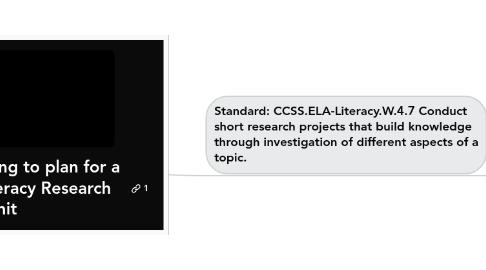
1. Standard: CCSS.ELA-Literacy.W.4.7 Conduct short research projects that build knowledge through investigation of different aspects of a topic.
1.1. BIG IDEAS The students will create a research report. The class will put on a news program with a focus on history. Each student will get to be a newscaster and report on an event in history. The students will make a Prezi presentation, and will have to use graphics and videos to enhance their presentations. The parents will be invited to watch.
1.1.1. Factors affecting choice of scaffolding: students prior knowledge, grade and age appropriate strategies, different learning profiles, different types of learning experiences. The subsequent scaffolding strategies will be adjusted according to the aforementioned factors and the teacher's assessments of her students before and during a lesson.
1.1.1.1. Objective 1: The students will examine the structure of paragraphs with the aid of graphic organizers and begin to plan for the construction of his/her own informative paragraphs.
1.1.1.1.1. Scaffolding ideas for objective 1: The teacher will assess students prior knowledge regarding the components of a paragraphs by having a group discussion. This is a skill that was covered in previous grades. 2 articles will be examined to help determine what students already know about the components of paragraph. This discussion will guide the teacher in the amount of guidance and enrichment the students will need with the paragraph graphic organizer included in their graphic organizer.
1.1.1.2. Objective 2: The students will choose strong verbs to convey his/her ideas precisely.
1.1.1.2.1. Scaffolding ideas for objective 2: - “I do”: The teacher reads a news report on ˝The World’s Biggest Hamburger˝ without the use of strong verbs (1 page) and then again with strong verbs. The teacher identifies some strong verbs in the article using a think out loud. -“We Do”: The teacher asks the students to identify some strong verbs from the article. Each students is given ˝The World’s Biggest Hamburger˝ with the use of strong verbs and they have to create a list in their notebooks of strong verbs. After 8 minutes they have compare with their neighbour if they have the same verbs listed. -“You Do”: Using the chart that they created with strong verbs create 2 new sentences with a strong verb. The teacher will circulate to assist students who need help.
1.1.1.3. Objective 3. The students will access a variety of resources (online, books, interviews, etc) to collect information for his/her informative writing piece.
1.1.1.3.1. Scaffolding ideas for objective 3: - ˝I Do˝: The teacher will model how to search for an article on a reputable site (list provided in a handout) and use Diigo for highlighting important content (computer screen projected). The teacher will think out aloud while she completes this task. - “We Do” The teacher will ask the students to guide her through finding an article on Neil Armstrong using their handout on reputable sites and Diigo. - “ You Do˝: Students will search for an article on their topic and practice using Diigo. Homework: search and highlight one article for their research report. The teacher will circulate to assist students who need help.
1.1.1.4. Objective 4. The students will verbally summarize several informative pieces of writing by identifying and discussing the main ideas.
1.1.1.4.1. Scaffolding ideas for objective 4: - ˝I Do˝: The teacher will model how to identify one ¨big idea in the news clip¨ the class watched together. She will model how to rewrite the ˝main idea˝ in her words (avoiding plagiarism). - ˝We Do˝: Students will help with the subsequent main idea points. - “You Do” Students will be placed in 3 groups (based on their reading level) to summarize the article: ¨Astronomers say they found a "Super Earth" beyond dwarf planet Pluto˝ (using Newsela which levels the article re their assigned group level. Each group shares their main points . The teacher will circulate to assist students who need help.
1.1.1.5. Objective 5. The students will synthesize research material in order to internalize it in a way that they can use it in their own report without plagiarism.
1.1.1.5.1. Scaffolding ideas for objective 5: The teacher will have a discussion regarding what is plagiarism with the class accessing what they already know about the topic. “I Do” The teacher will model how to play the “Find the Copy Cat”. A fact card and sentence card will be drawn. The teacher will use a think out loud to reason how she determines if the sentence is plagiarized or not. “We Do”: The teacher draws a new set of cards and the class will have to share reasoning for the answer. This will be repeated as many times as necessary. “You Do”: Students will be split into two groups to play the game. Bonus round a fact card is drawn and students need to come up with a original sentence.
1.1.1.6. Objective 6. The students will use the writing process to publish an informative book report, news report or research paper about real events from our past.
1.1.1.6.1. Scaffolding ideas for objective 6: At the beginning of the unit a research package will be provided with the components of the writing process: Ie. Topic brainstorm, Key Questions, facts to answer key questions, paragraph organizer, editing checklist and reference chart. The unit will be planned to use each section of the research package.
1.1.1.7. Objective 7. The students will cite sources that he/she used.
1.1.1.7.1. Scaffolding ideas for objective 7: The teacher with the class will create a mindmap for the components of a complete bibliography. The students will complete the mindmap in their research package. “I Do”: The teacher will model using the mindmap how to write a reference for the bibliography. “We Do”: The class will us a sample book to write the references together. “You Do”: The students will write the bibliography section. The teacher will circulate to assist students who need help.
